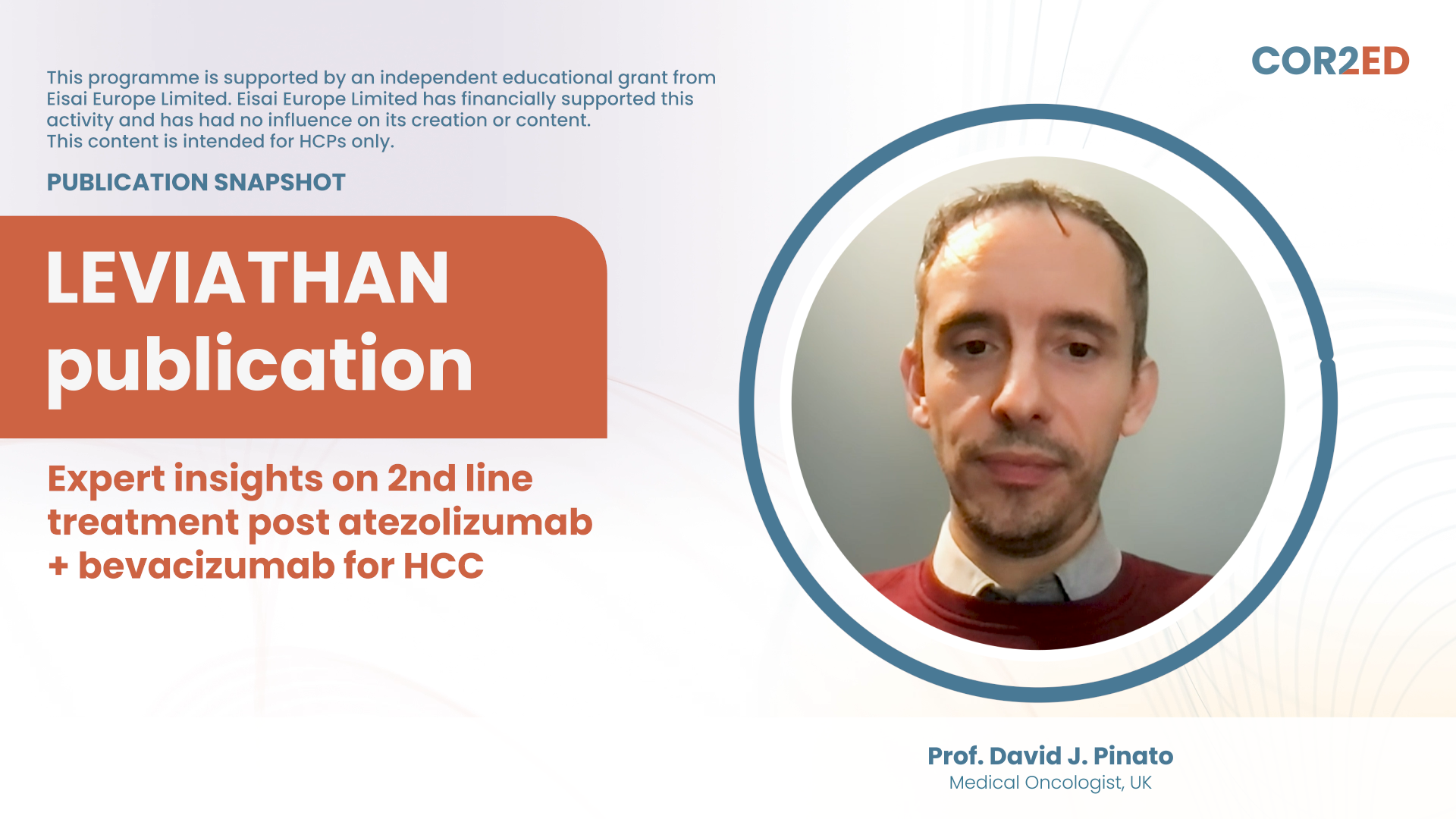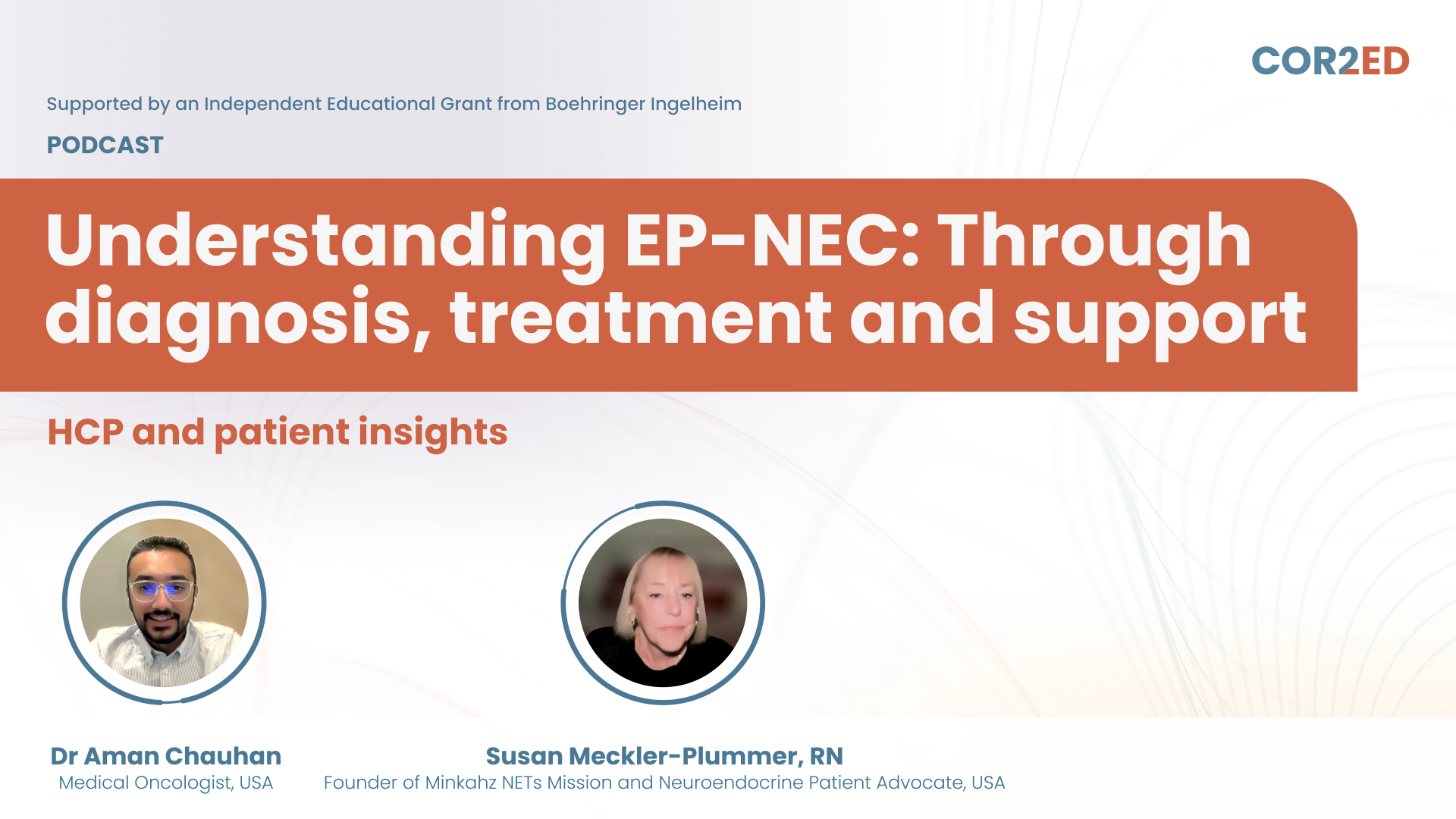Podcast Transcript
Lung Cancer: Pre-Analytical Phase Challenges and Biomarker Testing
Moderated by:
Drs Rahul and Rohit Gosain, the Oncology Brothers.
Brought to you by:
Dr Bruna Pellini, Medical Oncologist, H. Lee Moffitt Cancer Center and Morsani College of
Medicine at University of South Florida, Florida, US.
Dr Semir Vranić, Associate Professor of Pathology, College of Medicine, Qatar University
Doha, Qatar.
Introduced by:
Tonke de Jong, COR2ED.
Please note:
PRECISION ONCOLOGY CONNECT podcasts are designed to be watched and/or heard. If you are able, we encourage you to listen to the audio, which includes emotion and emphasis that is not so easily understood from the words on the page. Transcripts are edited for readability. Please check the corresponding audio before quoting in print.
This podcast is an initiative of COR2ED and developed by PRECISION ONCOLOGY CONNECT, a group of international experts working in the field of precision oncology. The podcast is supported by an independent educational grant from AstraZeneca and Amoy Diagnostics.
The views expressed are the personal opinions of the experts. They do not necessarily represent the views of the experts' institution, or the rest of the PRECISION ONCOLOGY CONNECT group.
For expert disclosures on any conflict of interest please visit the COR2ED website.
Tonke de Jong (COR2ED)
Pre-analytical phase errors account for the majority of errors in the analytical workflow with the potential to impact biomarker test results, patient safety and increase the cost burden for laboratories. It's important to highlight where these can occur and how to avoid them. Keep listening to find out more. This is the second podcast episode in a three-part series on pre-analytical phase errors in biomarker testing. In this episode, we focus specifically on lung cancer. This podcast is an initiative of COR2ED and supported by an Independent Educational grant from AstraZeneca and Amoy Diagnostics.
Dr Rahul Gosain (Oncology Brothers)
Hello everyone, I am Rahul Gosain.
Dr Rohit Gosain (Oncology Brothers)
And I am Rohit Gosain.
Dr Rahul Gosain (Oncology Brothers)
And we are the Oncology Brothers. Over the last few years, lung cancer has been the poster child for precision medicine with more than 50% of the adenocarcinoma histology for non-small cell lung cancer and metastatic disease potentially has a driver biomarker, be it high PD-L1 or KRAS or mutations such as EGFR or ALK. However, this information can get compromised due to pre-analytical phase challenges. To better understand the implications of having the right tissue, running the right test, and then applying this in our day-to-day practice. We're joined by Dr Bruna Pellini from Moffitt Cancer Centre, who's also the co-chair at NIH for Liquid Biopsy Scientific Interest Group, and Dr Semir Vranić, a pathologist from Qatar University in Doha, Qatar.
Dr Rohit Gosain (Oncology Brothers)
Welcome. Thanks for joining us.
Dr Bruna Pellini
Thank you for the invitation. Pleasure to be here.
Dr Semir Vranić
Thank you too. I'm also very honoured and pleased to be with you today.
Dr Rohit Gosain (Oncology Brothers)
Thanks for those kind words. Rahul, just starting off, you mentioned pre-analytical phase challenges. Semir, we'll start off with you from pathology standpoint from non-small cell lung cancer, what does the pre-analytical challenges really entail to you?
Dr Semir Vranić
Again, thank you very much for kind invitation to be involved in this very important podcast about pre-analytical issues related to non-small cell lung cancer. There are multiple aspects related to pre-analytical phase of non-small cell cancer diagnostics, but it's also very general pertaining to other cancer subtypes. But specifically in the context of non-small cell lung cancer, there are issues relating to specimen collection which can vary and can be suboptimal in some cases. Also, processing of the tissue may also vary, and may be suboptimal. I believe we'll discuss it in more details later as well. Also, the cutting procedure can also vary from institution to institution. There are many variations in this regard. The storage as well, and also many institutions, they have different policies regarding how many cuts, how many samples are taken for routine diagnostics, not taking into account the consequences in case when the tissue is limited in terms of the quantity and quality of the cells that are obtained during the biopsy. So, these are general issues related to pre-analytical challenges related to non-small cell lung cancer management.
Dr Rahul Gosain (Oncology Brothers)
Semir, thank you for at least laying that foundation. Bruna, as a medical oncologist, what are some of the implications that we run into from these errors or challenges in our day-to-day clinic practice?
Dr Bruna Pellini
So, if we don't have a good specimen, we are not going to be able to run our comprehensive genomic testing. That is the standard of care, because there's so many genes that we have to interrogate. And if one were to choose to do one by one with a very scarce tissue, then you're not going to be able to run every single gene. So, we have six targets that we have available therapies in the first-line setting EGFR, ALK, RET, BRAF, MET exon skipping mutation and ROS. Yes, so six. And then second line HER2, KRAS and NTRK. So, I already have nine targets. So, if I run one by one and if you rely on your memory to get each single test, that's not going to work very well. So, knowing that tissue is the issue, always go for a comprehensive genomic panel, one test for everything. And that should be the standard, and that should be what we are all doing really for patient care.
Dr Rohit Gosain (Oncology Brothers)
Yes, Bruna couldn't agree more. And one has to realise that these are targetable mutations that we have first-line drugs available. Rahul, you mentioned lung being the poster child for this. Well, talking about breast cancer, as Dr Mark Lewis once stated that you would not treat any breast cancer patient without knowing ER, HER2 or PR. So, in this case, in the personalised medicine era, same thing applies for lung or any other solid tumour at this point in time when we have these targetable mutations. And if we are not doing this, we are really depriving patients from their therapy here. Now knowing histology, is certainly not enough. But, now moving along, Bruna, in your clinic, if you have a patient that you are suspecting metastatic lung cancer, specifically non-small cell lung cancer, what does your workup in terms of obtaining tissue or diagnosis looks like?
Dr Bruna Pellini
So, if I see a metastatic site that has a good size, I'll go for a core biopsy of the metastatic site. Otherwise, if there's a lung mass that is close to the chest wall, I can do a CT guided biopsy of that or ultrasound guided biopsy of a large lymph node in the neck, it's also very reasonable. But we should always aim for a core biopsy. One thing that routinely happens, for instance, a stage 3 disease, maybe stage 4, maybe there's a bone metastasis, we are not sure, patients may go to an EBUS. The challenge with EBUS is the size of the needle that they use. The routine standard needle doesn't get tissue in a core format, so it's mostly fine needle aspiration. And that is really challenging because often we don't have enough tissue to run our next generation sequencing panel with that sample. But there are institutions that if you talk to the interventional pulmonologist, they may be able to change the needle that they are using and get a core, but that's not standard. So always try to go for a core biopsy guided by imaging, that’s number one. Avoid bone, because when you have to remove the calcium, we are removing all those precious cancer cells that you are going to need for testing. So, and if you must do an EBUS, try to talk to the interventional pulmonologist to see if there's any way to get more specimens from different areas, or the needle can be changed. That's what I would do.
Dr Rahul Gosain (Oncology Brothers)
Bruna, thank you. Semir, this is this is your forte, for an interventional radiologist or pulmonologist who are most often doing these biopsies for us, what Bruna brought up, FNA ends up being something that we run into. But quantity and quality both matter here. What would you say to them about getting sufficient and adequate tissue here?
Dr Semir Vranić
Yeah, that's critical actually, the issue obtaining sufficient and adequate tissue for the analysis. There are there are options that are available. Bruna mentioned some of them and ROSE (rapid on-site evaluation) is possible to assess the quality and quantity of the obtained cells, for instance, for cytology. But still, this is not available everywhere. CAP, College of American Pathologists, guidelines recommend ROSE, rapid on-site evaluation, if possible but in many institutions worldwide, unfortunately it's not possible. So, biopsies are also frequently performed as Bruna already said. But again, sufficient tissue remains an issue. And what is optimal tissue in terms of quantity, it's usually five X five millimetres or roughly, 25mm² of tissue. So, content should be more than 20% of tumour cells, which is minimum 20% to 40%. It's acceptable, and more than 40% of tumour cells is generally considered very good sample for all the molecular ancillary techniques. So, this is general approach. But occasionally it may vary. For instance, in case of liver biopsy because of hepatocytes polyploidy the content must be higher because hepatocytes especially with ageing they have more DNA content. So, in that case percentage should be double than usual. So, it can be 40%. But in any case, all the institutions that perform gene sequencing or a large panel analysis, they can perform in case when they assess that the tumour content in terms of quantity and quality is not enough, not satisfactory. They can perform dissection, microdissection, or laser microdissection to enhance the quality in terms of the quality and quantity of the tumour cells for the analysis. Pathologist plays a crucial role in providing a good sample, the sample that is, that has a minimum of necrosis, fibrosis and inflammation, the things that should be maximally avoided not to contaminate the sample for the molecular analysis. So, these are basic principles.
Dr Rohit Gosain (Oncology Brothers)
With regards to the basic principle that you laid out, Semir you are practising in Middle East and trained in U.S. and Italy. Now, talking about the regional differences, is that something quite a bit similar to what you stated from the principal standpoint, or that differs when you go to different regions?
Dr Semir Vranić
Yeah, some principles I think are more or less the same. I was checking the guidelines across the world from Asia to South America, ESMO and CAP guidelines. Some principles are the same, like fixation, okay. Fixation time, for instance for small samples should be 6 to 24 hours - shouldn’t be less than 6 and more than 20, a maximum 48 hours for small samples like core biopsy fixation. Cold ischemia time, so-called time when the specimen is taken and the fixation start, should be a one hour maximum. All right. Fixative usually it's a 10% neutral formalin. It's widely accepted, and most institutions do so. But I can tell you that I did the recent survey with my U.S. colleagues and found that the results from some parts of the world, mainly non-European, from Asian and African countries, fixation was not proper in the terms, probably of the because the quantity and quality of the tumour cells for DNA extraction for molecular tests was not proper. So, although there is general agreement about the fixation time, type of fixative, the practice is probably, in real life is very different. In this part of the world, it's like rest of the world. But I'm telling you about the experience from elsewhere. So, there should be more efforts to standardise these things cold ischaemia time, fixation time, fixative and of course all other pre-analytical things that we mentioned previously, like cutting the specimen, how many slides and all these things which are essential, you know to preserve, to save the tissue for the ancillary techniques, not to waste the tissue on redundant or unnecessary points as immunostaining, to limit the immuno panels for diagnostics, 2 to 3 antibodies like – TTF1 and P63 or P40, depending on institution. Not to waste on other antibodies because these slides could be utilised for molecular profiling and precision medicine purposes.
Dr Rahul Gosain (Oncology Brothers)
Absolutely. I think a few things, all of us on this call are privileged to work in centres or facilities where we have access to comprehensive testing or to these medications. Globally, we need to make these tests and these medications available for all our patients.
Dr Semir Vranić
Absolutely.
Dr Rahul Gosain (Oncology Brothers)
Bruna, coming back to the patient that we started off with, potentially we think this is non-small cell lung cancer. In the community, this patient ends up going to interventional pulmonary gets an EBUS. They get an FNA. And now you have just small tissue to make the diagnosis that this is indeed non-small cell lung cancer adenocarcinoma, but not enough tissue to do anything further than what we have already. What next, what are you going to do?
Dr Rohit Gosain (Oncology Brothers)
And sadly enough, this is not the most uncommon thing we see. We see this very commonly unfortunately.
Dr Bruna Pellini
Right. So, I feel like one strategy that is in IASLC guidelines is to pursue liquid biopsy if you don't have enough tissue. I just feel like there are a few things that people need to be aware that they influence the likelihood of a liquid biopsy being false negative. Number one, if a patient only has lung nodules as the metastases, there's no disease elsewhere, there's a good chance there's going to be a false negative, because it sheds less. Adenocarcinomas shed less DNA. So, with the squamous you most likely will find, but then they usually don't have the targets that we're looking for. Another situation if a patient only has a bone metastasis limited, so oligometastatic disease, there's another situation where the liquid biopsy may be a false negative. So, remembering, lung nodules, pleural effusions only patients, or a single or limited bone metastasis low yield for the liquid biopsies, you should still order. We shouldn't be convinced there's nothing if it comes back negative. That's number one. Number two is always you can try to pursue another biopsy, which I have done in situations where I feel like this patient may have an actionable mutation. Somebody that is older, has never smoked, comes from ethnic background that I know there's a higher chance of having x, y mutation. Then I'll repeat the biopsy and run the test. But in general, I like liquid biopsies. I ordered them, but when they're negative, especially in the situations, just remember we have to go for tissue again.
Dr Rahul Gosain (Oncology Brothers)
Thank you. I started off by saying we're privileged, and that's one thing that a lot of us concurrently do liquid biopsy and tissue biopsy. But Bruna, the point that you make, I want to reiterate that having something negative in liquid biopsy, you don't need to stop there. The solid tissue biopsy is still the gold standard. If you find something in the liquid biopsy you act on it and you can move on, but just if something is negative and liquid biopsy does not mean you don't need to chase the gold standard, which is still the tissue.
Dr Bruna Pellini
Correct.
Dr Rohit Gosain (Oncology Brothers)
When we're talking about the false positive and false negative there, I just want to bring up that when we often see the lung cancer patients with not a lot of tumour burden, but they will come with massive pleural effusions. Now, we have cytology which has confirmed non-small cell, particularly adenocarcinoma, can you rely on an NGS panel there, just on cytology or just pleural effusion for that matter?
Dr Bruna Pellini
So you can try to extract enough cells from the pleural fluids, spin them down and extract the DNA from them and run the NGS, so much like you do in a core biopsy. But you have to have your best friend pathologist letting you know if the sample is good or not. One thing that I would like Semir to let me know, because in-house our pathologists they always write in the report ‘material is sufficient for molecular testing’ so, I know ahead of time if the tissue is good enough. But I don't think that's the standard. And I wish it was because it would help so many people in the community especially.
Dr Semir Vranić
Again, yeah, it's all about the quantity and quality of the cells. And I understand fully about what you talk about. And in many cases, it's not easy to obtain and repeating the biopsy, it's another issue. But I think combination particularly in advanced disease, a combination of tissue biopsy and, in case it doesn't work, with the liquid biopsy may give the best results.
Dr Rohit Gosain (Oncology Brothers)
And Bruna you bring up a good point, although I work in a rural setting where I have access to the pathologist very easily and rapidly, so they are able to communicate that with me. But it will be very important for a pathologist to just state that right away if this is enough tissue. If not, then one can start making arrangements, especially when you're dealing with these patients who are progressing on this cancer very rapidly.
Dr Bruna Pellini
Yes, I wish the CAP would make this standard practice of reporting, because otherwise you would have to call the pathologist, ‘is there enough cellularity for me to run that NGS?’. I feel like it's one line in the report that makes a huge difference, because if I know there's enough material, the material is in-house. I don't need to send the liquid, especially when I have limited resources and I have to elect what I'm going to put my money on. If I have that information, I know as long as they run it, it’s going most likely be a good sample because the pathologist already reviewed the cellularity and the quality, then they can rely on that and calm myself and reassure the patient, in 4 weeks, we're going to have the results. It's not going to be 4 weeks and then we have nothing and then now I have to order something.
Dr Semir Vranić
Yeah, yeah. The issue here is also is it the first time the patient is being diagnosed. So, pathologists will not spend the tissue on confirmatory test like immunohistochemical test like TTF, P40 and others. Or is it recurrent disease, and we know it's adenocarcinoma non-small cell lung cancer. We just need to assess the quality and quantity of the cells. There are two issues here. If it's a recurrent disease and we know it's malignant disease, confirmed disease. In that case the job is it's a bit easier. But if you ask pathologists for the first time and he thinks in advance that there may be cuts necessary for confirming the type of the disease, the things really become different. And of course, the assessment of the quantity and quality of the cells is somehow subjective, a subjective assessment. Again, saying five X five mm that 20% of the cells, it's really very subjective. We still don't use artificial intelligence to quantify, precisely quantify, that these percentage of the cells and it's a just rough estimation. I hope you can appreciate it. So, but again, skilled experienced pathologist can provide, I'm sure, reliable information regarding the quality of the obtained specimen, regardless of cytology or biopsy for molecular tests. Again, it's very important from my point of view, that pathologist is really aware of the limited specimen and try to spare the tissue as much as possible for ancillary tests. That's the key issue. So, pathologists must really take care of the specimen, somehow guardian of the specimen. Not to waste the tissue on unnecessary stains, for instance, when it's obvious that it’s primary adenocarcinoma not to waste on additional sections. Also, the sectioning itself, upfront sectioning for molecular tests is that is in most institutions is standard of care. So, there is no waste of the tissue while technician or biotechnologies is cutting the specimen. So, there are technicalities that are also very important, usually developed in-house that enable proper tissue processing for a non-small cell lung cancer molecular profiling.
Dr Rohit Gosain (Oncology Brothers)
I certainly agree very much.
Dr Rahul Gosain (Oncology Brothers)
Semir, you brought up a few things that, none of this is objective measure, which makes it difficult for us to have that standardisation, be it in community or where you are in the Middle East or in academic centres. So, I think that's one big reason that we have to be mindful. Bruna, we started off by you saying that you rely on comprehensive testing rather than spot testing. Semir, is that your practice as well, that you rely on a big genomic sequencing rather than spot testing? Because I would think that when we're doing spot testing, these pre-analytical errors play even a bigger role in that setting.
Dr Semir Vranić
Absolutely, absolutely. That's why I think comprehensive genomic profiling is the standard of care. And if you go to the most updated guidelines regardless of US, Europe, ESMO, wherever, they strongly advocate for comprehensive genomic profiling particularly in advanced setting. No doubt about that, but it's critically important for non-small cell lung cancer where you have so many targetable genomic alterations and more coming, more on the way. So, there is no chance to do a single test anymore - you waste the tissue, you waste the money. And you know, oncologists know better than me how important the timing for the treatment of a non-small cell lung cancer patient is. So just comprehensive genomic profiling, NGS should be standard of care for all patients. As we know, it's not only about mutations. It's also about some other genomic alterations, fusions. So single tests do not make sense to me.
Dr Rohit Gosain (Oncology Brothers)
Thanks. Semir. Bruna, now we have this metastatic patient where we got excellent interventional radiologist who got an excellent tumour specimen for us. And we got mutational testing. Unfortunately, the cancer progressed. Do you now rely on tissue, or liquid biopsy, or both on progression?
Dr Bruna Pellini
So, I'd say that is especially for genomic driven tumours, or driven by fusions, I try to get tissue because of transformation. There's no way with a liquid biopsy that you're going to find out it could transform to a small cell. And we all have seen that happen. So, if I can get tissue, perfect. But liquid biopsy has been widely used and I use that as well. It just depends on the resources because we're spoiled in the United States. So, we also have to be aware of the limited resources elsewhere. So, if I had to choose one and I can access tissue, I'll go with that because I'll answer two questions. But if I can do both, then I would definitely do both, because if, like Rahul said, if you find something on the liquid biopsy, you can act on it, and it comes back earlier.
Dr Rahul Gosain (Oncology Brothers)
Bruna, what you mentioned, looking for either resistant or transformation ends up being important and ideally tissue can give you that information if you don't have the liberty to chase, in that scenario, again, relying on liquid biopsy is favourable. The other thing I think we are talking about this, but this is not happening in silo in most of the places. Thankfully, we have access to multidisciplinary tumour boards where you have a pathologist, surgeon, radiation oncologist and medical oncologist all come together saying ‘I would access this tissue’, the pathologist is reading out what they're looking at. So, I really think that having that multidisciplinary discussion or tumour board is so important. Bruna, any last-minute takeaways for our listeners today?
Dr Bruna Pellini
I think if we can just remember the importance of doing next generation sequencing and comprehensive genomic testing in everyone, and if it hasn't been done for whatever reason, then you see this patient, just do it. It's ideal to do right before you start anything, but if it hasn't been done, just do it. So, I think that's my wish list for 2024 for every single patient that has non-small cell.
Dr Rohit Gosain (Oncology Brothers)
We definitely want to echo that because, again, this is what makes it personalised era of medicine. We can continue to do as much research we want. We can have many FDA approvals, however, unless we are doing this testing, unfortunately, these drug approvals stand nowhere. Semir, any final words before we go, sir?
Dr Semir Vranić
Yeah, I fully agree with what Bruna said. But again, practices may be different around the globe. It's not only US. There are many other practices around the globe, and there are also many differences in practising even precision medicine in some limited settings. I think if comprehensive genomic profiling is not widely available, accessible for various reasons, at least what I would do, it's a minimum testing that should be done in all patients with non-small cell lung cancer, particularly in advanced setting. It's EGFR testing, definitely, at least in-house most of the pathology labs worldwide they have immunohistochemistry, and there are reliable immunohistochemical markers for ALK alterations, for BRAF, ROS and of course for PD-L1. So, this is somehow, in my view, sort of minimum panel of biomarkers that should be done in limited setting. If not, if comprehensive is available, of course go ahead. Don’t forget, in Caucasian population, the frequency of EGFR mutations is relatively low 10 to 15%. In the Asian population it goes far higher, it's goes 50-60% up to 70%. So, in such cases, EGFR testing is of utmost importance and comprehensive as you know, it's not enough to screen just the exon 19, or 21. Exon 20 should be covered as well. So, comprehensive NGS again comes as a proper option to spot all the relevant genomic alterations even within the EGFR gene.
Dr Bruna Pellini
For EGFR mutations, I think we have to be cautious when relying on single gene testing because while the exon 19 deletion L858R will be caught, exon 20 insertion, given the position on the gene is going to be missed by several of this EGFR testing. So, knowing that you have to talk to the pathologist then because you don't want to miss that target, because we do have therapies available for that now and I have seen that being missed on the prior sequencing of EGFR, for instance, and that is used in some institutions.
Dr Rahul Gosain (Oncology Brothers)
Adding on to the theme of being missed out, the other thing is, when we're talking about comprehensive nowadays, it's not only DNA, but we’re also looking for RNA, which at times again can miss out. So, you can argue and debate that liquid biopsy is more sensitive for looking for these mutations. But again, the theme here is comprehensive testing perhaps is significantly better, which is endorsed by multiple societies and guidelines that that is what we should rely on.
Dr Rohit Gosain (Oncology Brothers)
Amazing. One could talk about this on and on and on because there's so much to cover. But we have indeed covered quite a bit here. Bruna and Semir, thank you so much for joining us today. To the listeners, please make sure to also look out for similar discussion in prostate cancer and soon in ovarian cancer. And we are the Oncology Brothers.
Tonke de Jong (COR2ED)
Thank you so much for sharing these important messages on reducing pre-analytical phase errors and biomarker selection in lung cancer. We've learned a lot, and I take with me that there are various ways to optimise lung cancer samples. If you liked this episode, then please look for the other episodes in this series, coming soon on the Oncology Medical Conversation podcast under the account of COR2ED Medical Education, where we discuss reducing pre-analytical phase errors and biomarker testing in ovarian cancer.
If you're interested in finding out more about precision oncology, then please visit cor2ed.com and select oncology. If you like this podcast, then don't forget to rate this episode, subscribe to the channel, or inform your colleagues about it. Thank you for listening and see you next time.
This podcast is an initiative of COR2ED and developed by PRECISION ONCOLOGY CONNECT, a group of international experts working in the field of oncology. The views expressed are the personal opinions of the experts and they do not necessarily represent the views of the experts' organisations, or the rest of the PRECISION ONCOLOGY CONNECT group. For expert disclosures on any conflict of interest please visit the COR2ED website (COR2ED.com).
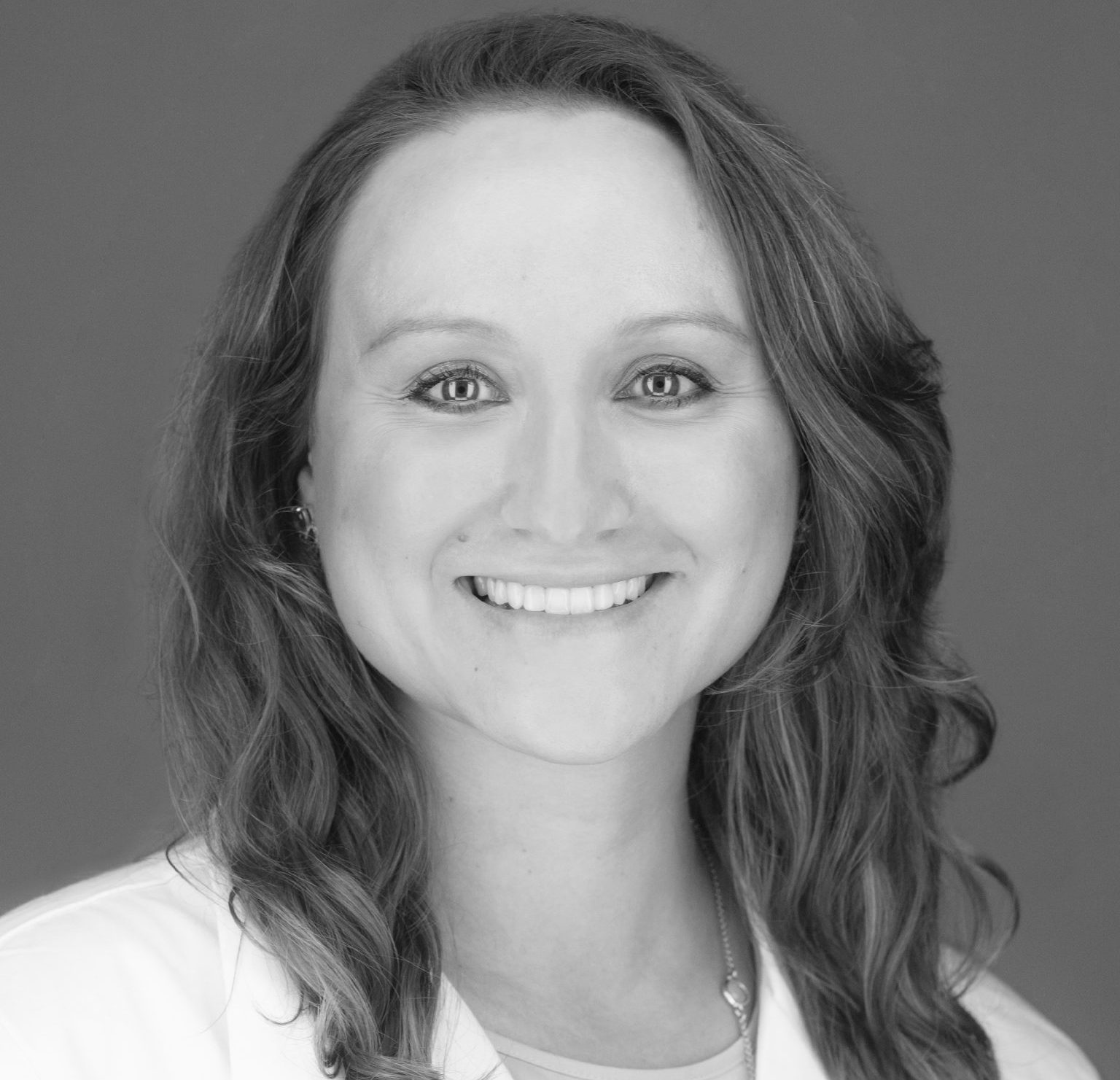
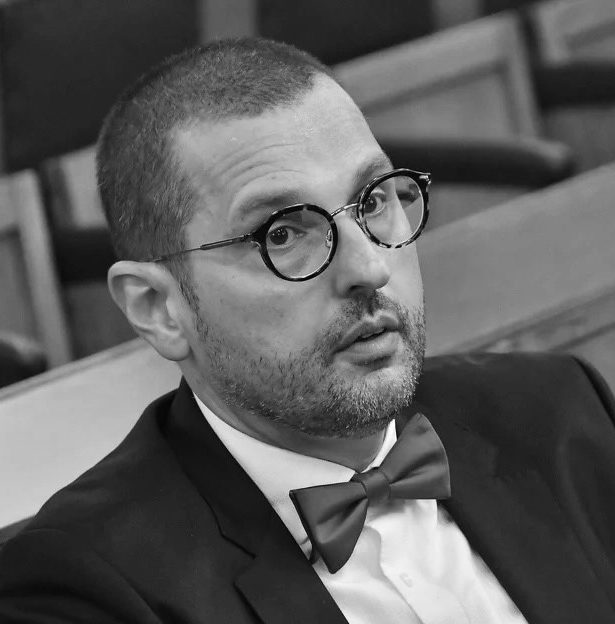
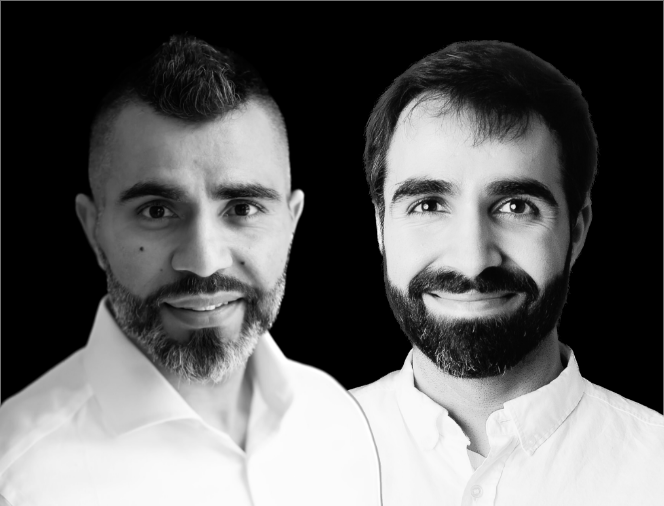


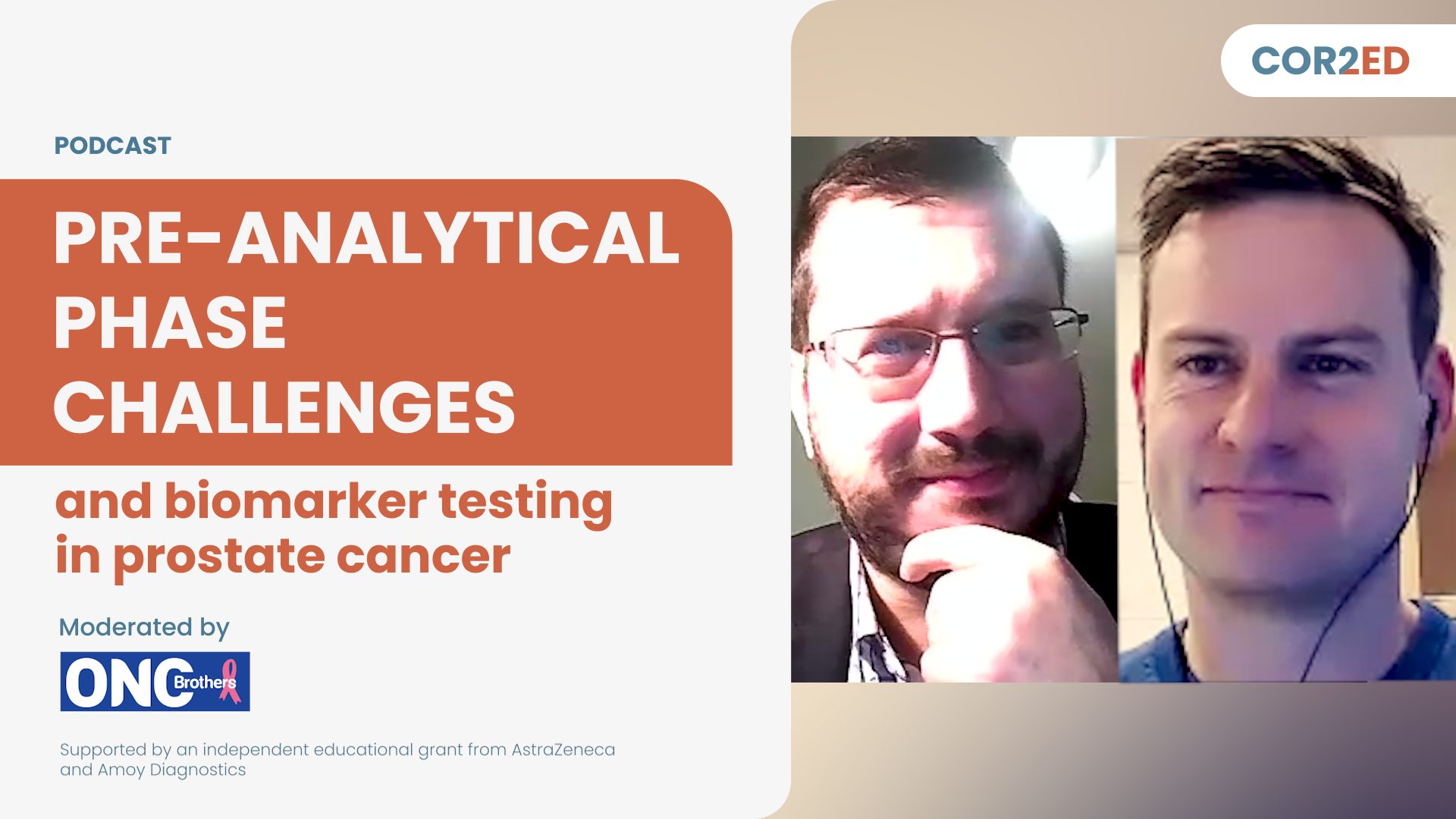
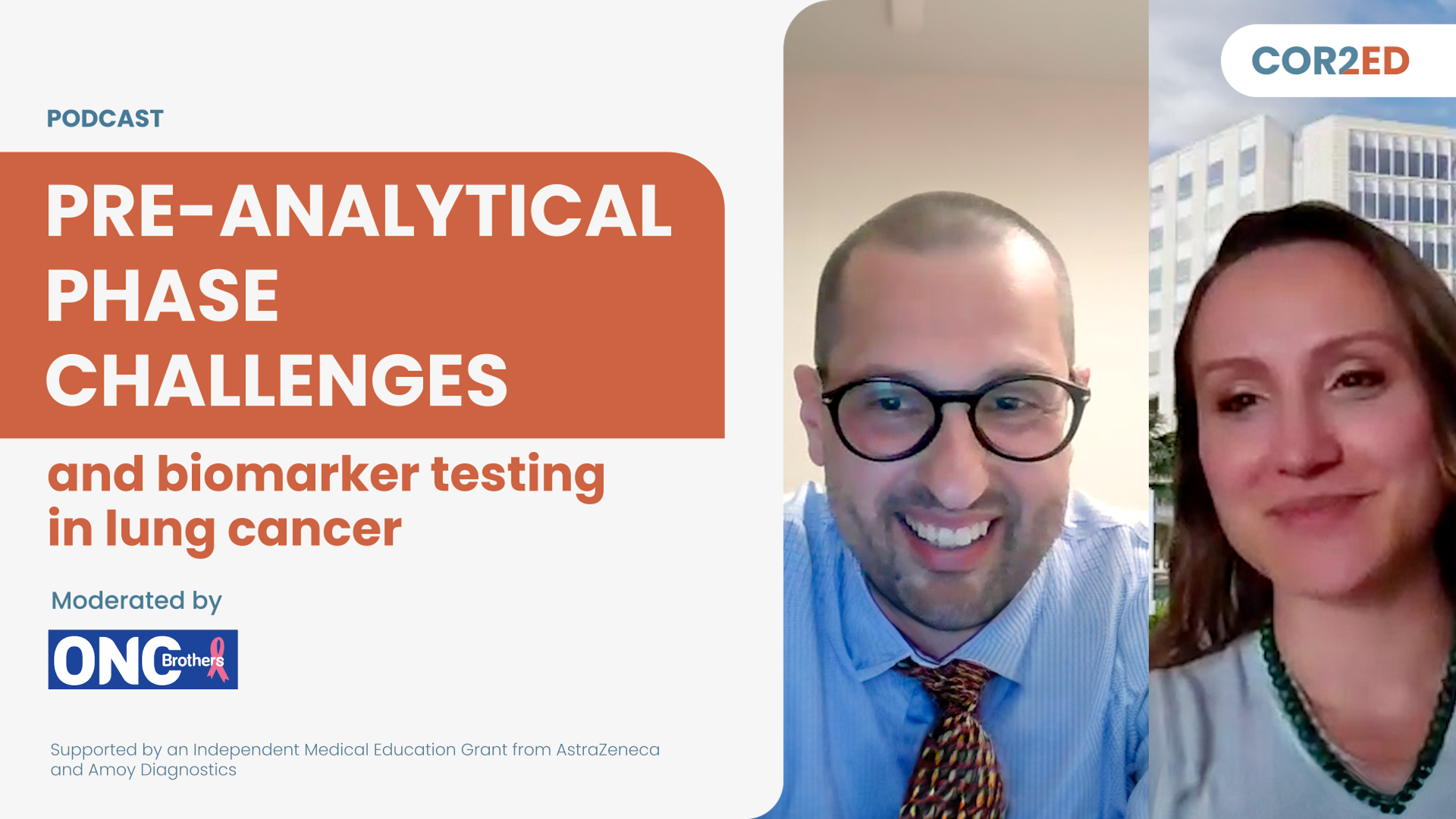
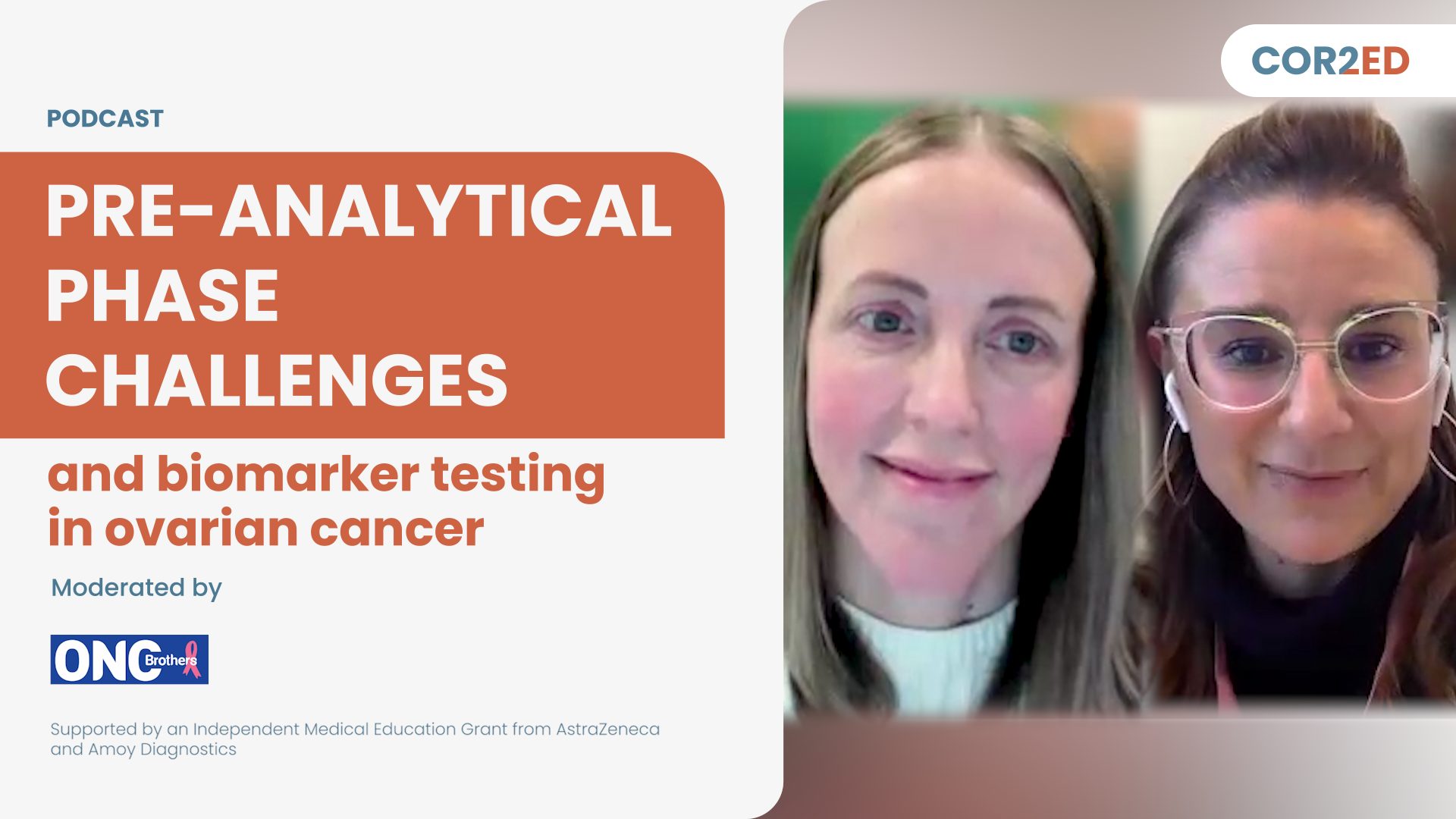

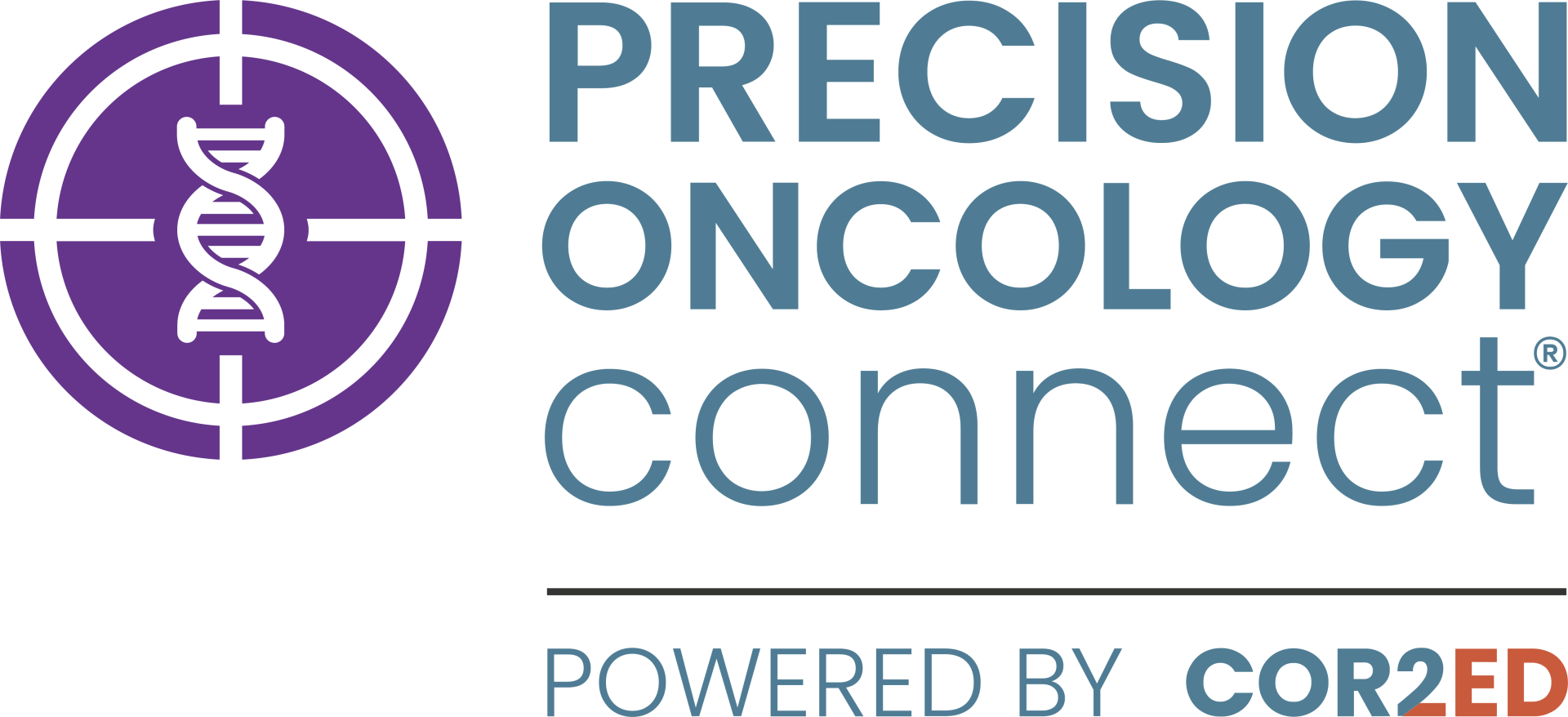
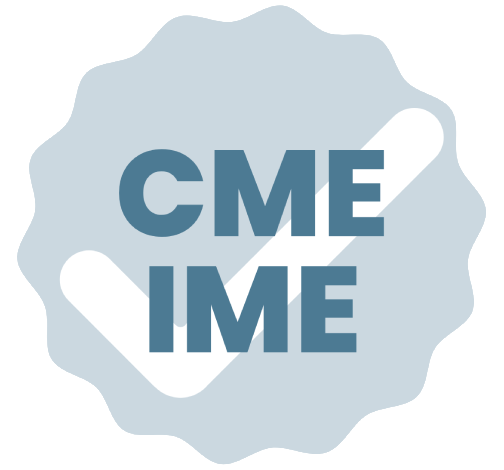


 5 MIN
5 MIN
 Dec 2025
Dec 2025 
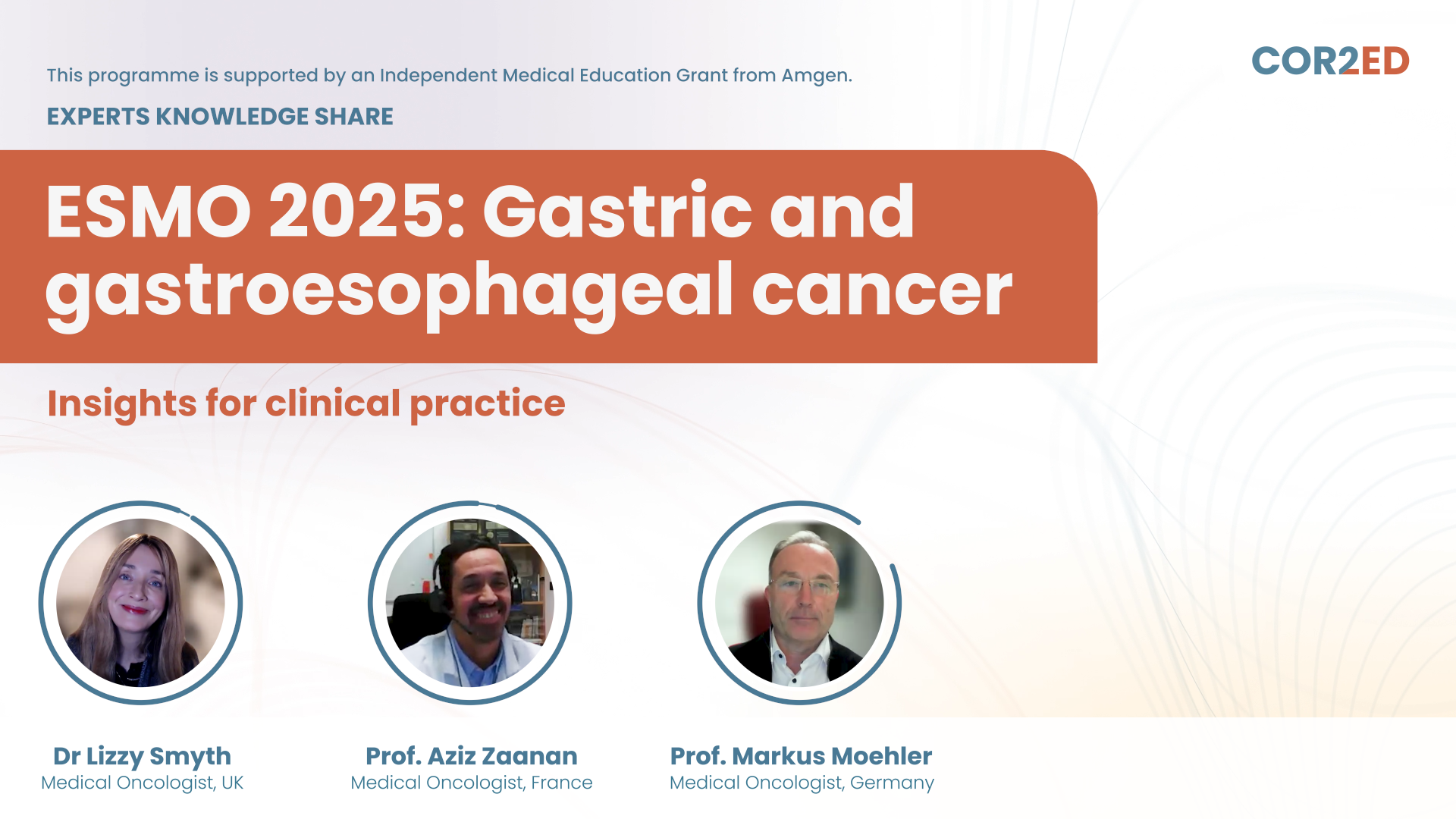

 Downloadable
Downloadable 